Kristianstad
Kristianstad (UK: /ˈkrɪstʃənstɑːd/,[2] Swedish: [krɪˈɧǎnːsta, -ɑːd];[3] older spelling from Danish Christianstad) is a city and the seat of Kristianstad Municipality, Scania County, Sweden with 40,145 inhabitants in 2016.[1] During the last 15 years, it has gone from a garrison town to a developed commercial city, today attracting visitors in the summertime mainly from Germany, Denmark and The Netherlands.
Kristianstad
Kristianstads kommun | |
|---|---|
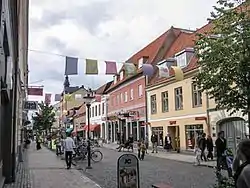 Kristianstad | |
 Coat of arms | |
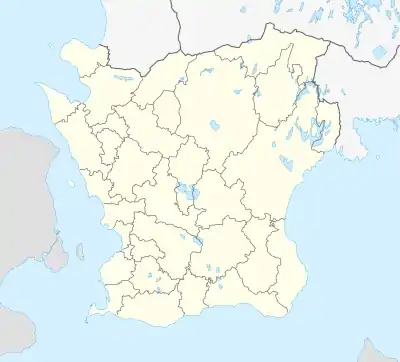 Kristianstad 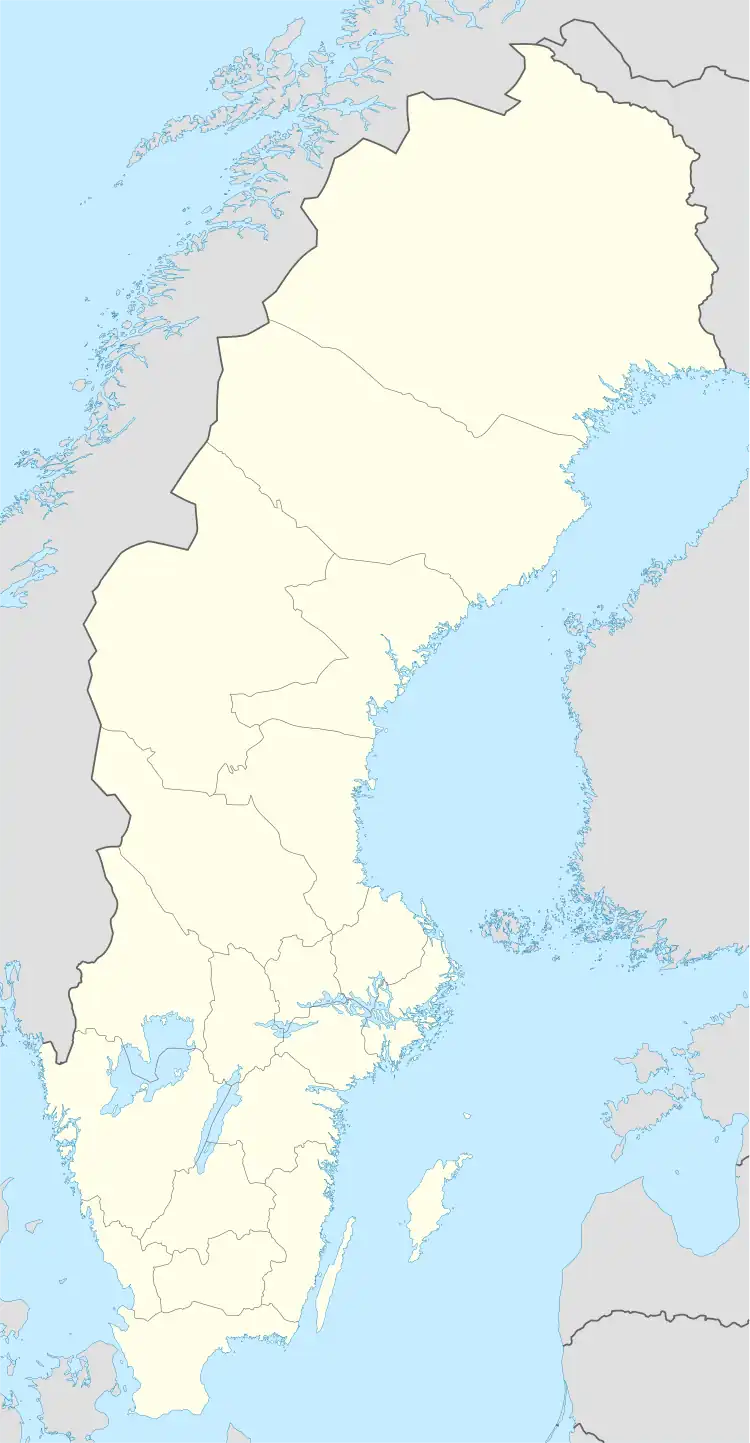 Kristianstad 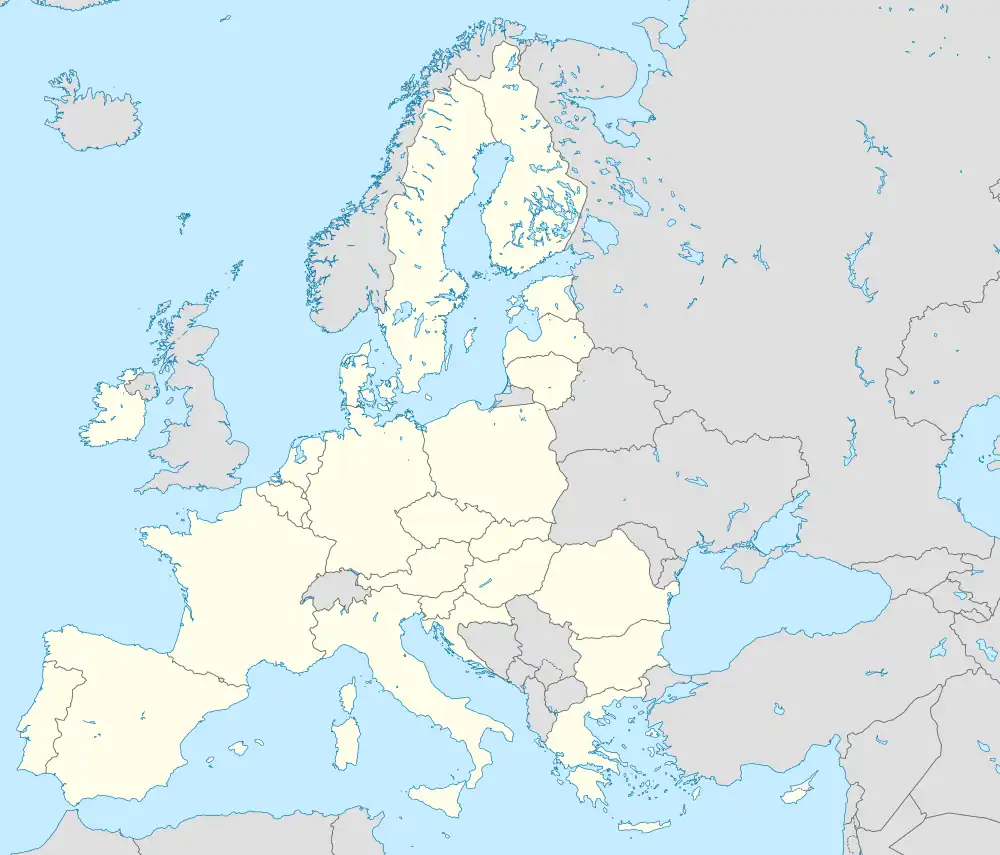 Kristianstad | |
| Coordinates: 56°01′46″N 14°09′24″E | |
| Country | |
| Province | |
| County | |
| Municipality | Kristianstad Municipality |
| Area | |
| • Total | 21.4 km2 (8.3 sq mi) |
| Population (31 December 2016)[1] | |
| • Total | 40,145 |
| • Density | 1,876/km2 (4,860/sq mi) |
| Time zone | UTC+1 (CET) |
| • Summer (DST) | UTC+2 (CEST) |
| Website | www |
History

The city was founded in 1614 by King Christian IV of Denmark (the city's name literally means 'Town of Christian') as a planned city after the burning of the nearby town of Vä and moving the city rights of the neighbouring town of Sölvesborg and Åhus to the new town. The purpose of the town was to safeguard the eastern half of the Danish province of Scania against any future raids from Sweden in the north, but also as a symbol of the power of Christian himself. One of these raids had sacked the nearby town of Vä in 1612. Vä then lost its charter and the people were moved to the new, better fortified city. The king also founded the town of Kristianopel in eastern Blekinge to serve a similar purpose.
Construction of the towns was a great prestige project for the king, and Kristianstad's church (Danish: Trefoldighedskirken; Swedish: Heliga Trefaldighetskyrkan) is considered by many to be one of the most beautiful buildings constructed by King Christian IV, or even northern Europe's most beautiful Renaissance church. This meant that the church was built considerably larger than there was initially use for. The king also wanted castle or fortress constructed inside the town but shortage of funds made this impossible, of the intended castle only an arsenal was constructed which today serves as the main building of the local museum. Also in Christianstad the town planning of the Renaissance could be laid down for the first time at the foundation of the town. This makes the Kristianstad town centre of today exceptionally well-kept and easy to get around in.
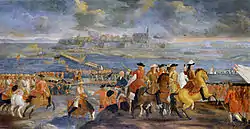
The city's coat of arms depicts two lions holding the King Christian IV's crowned insignia, the monogram C4. The coat of arms was only slightly modified after the Swedish takeover following the 1658 Treaty of Roskilde in which the eastern third of Denmark was ceded to Sweden. The coat of arms is very similar to the coat of arms of the former town of Christianopel in eastern Blekinge, a town also founded by Christian IV. Since 1971, the coat of arms is used by Kristianstad Municipality. Kristianstad's coat of arms is one of the few coat of arms in the world depicting a foreign king's or queen's coat of arms. A reason for the Swedes to continue using the old coat of arms could be its colours – blue and yellow, but Denmark is also held in high regard locally in Scania.
Pylyp Orlyk was after 1709 chosen as a Hetman in exile by the cossacks and the Swedish king Charles XII. While in Bender Orlyk wrote one of the first state constitutions in Europe. This Constitution of Pylyp Orlyk was confirmed by Charles XII and it also names him as the protector of Ukraine. After 1714 Orlyk now together with several other cossacks followed the Swedish king Charles XII to Sweden. Orlyk with his family and about 40 other Cossacks arrived in Ystad, Sweden in late November 1715. After some months in Ystad they lived in the city of Kristianstad for some years.[4] Orlyk wrote numerous proclamations and essays about Ukraine including the 1710 Constitution of Pylyp Orlyk.[5]
Kristianstad served as capital of Kristianstad County between 1719 and 1997. It now houses the administration and the regional parliament of the Skåne Regional Council. For a long time Kristianstad also was a very important garrison town, the A3 Wendes Artillery Regiment and the P6 South Scanian Infantry Regiment being the towns most prominent military units. Also the town housed for many years the so-called Scanian Fortification Brigade. The Wendes Artillery Regiment served with distinction in the Napoleonic Wars. One of Sweden's higher courts of appeal was located in Kristianstad before being moved to Malmö in 1917.
At the end of the 19th century, Christianstads Enskilda Bank (founded in 1865) issued banknotes with portraits of Christian IV instead of the Swedish king (the individual banks' right to issue banknotes ceased in 1898).[6]
Until 1996, Kristianstad was a city of residence in Kristianstad County, but in 1997 merged with Skåne County. Since the county councils were also merged into Region Skåne, the city became the seat of its regional council from 1999. The County Administrative Court in Skåne County was also located in Kristianstad until 2008.
In Kristianstad, seven countries have maintained honorary consulates during different periods. A Royal Danish Vice Consulate was established in 1855 and elevated to a consulate in 2002, but was withdrawn in 2012. A North American consular agency existed 1873 — 1887 (the same man was the Danish deputy consul and North American consular agent). The independent Kingdom of Norway established a deputy consulate in 1907, which was, however, withdrawn in 1937, to be re-established in 1946 and elevated to a consulate in 1988, but it is now revoked. Argentina had a vice consulate 1911 — 1935. Finland also had a vice consulate in Kristianstad 1923 — 1925 and 1931 — 1967. Lithuania established a consulate in 1995 and it is the only consulate left in Kristianstad today. Germany established a consulate in 1996, but it is now withdrawn.
Geography
Sweden's lowest point, at 2.41 meters below mean sea level, is located in Kristianstad. Because of this, parts of the city have to be protected from flooding by a system of levees and water pumps. To expand the city, large areas of low-lying wetlands have had to be walled in, especially to the east. To prevent future flooding of the city center, the existing levees are in the process of being reinforced and new levees against both Helge å and Hammarsjön are under construction. An extensive system of ponds and dams is also under construction. The threat of flooding became substantial during late winter 2002, when the greater part of the public park Tivoliparken was under water.[7] However, the wetlands around the city are starting to be regarded more as an asset, not least thanks to the creation of Kristianstads Vattenrike Biosphere Reserve.[8] Today the Vattenriket is a Unesco biosphere reserve.
Climate
Kristianstad has a humid continental climate. Summers are warm and comparatively long by Swedish standards.
| Climate data for Kristianstad, 2002–2020; extremes since 1901, precipitation 1961–1990 | |||||||||||||
|---|---|---|---|---|---|---|---|---|---|---|---|---|---|
| Month | Jan | Feb | Mar | Apr | May | Jun | Jul | Aug | Sep | Oct | Nov | Dec | Year |
| Record high °C (°F) | 11.6 (52.9) |
15.3 (59.5) |
20.4 (68.7) |
25.6 (78.1) |
29.5 (85.1) |
32.9 (91.2) |
32.9 (91.2) |
33.6 (92.5) |
27.5 (81.5) |
23.5 (74.3) |
17.7 (63.9) |
13.0 (55.4) |
33.6 (92.5) |
| Average high °C (°F) | 2.7 (36.9) |
3.4 (38.1) |
7.3 (45.1) |
12.5 (54.5) |
17.6 (63.7) |
21.0 (69.8) |
23.1 (73.6) |
22.2 (72.0) |
18.4 (65.1) |
12.3 (54.1) |
7.6 (45.7) |
4.4 (39.9) |
12.7 (54.9) |
| Daily mean °C (°F) | 0.3 (32.5) |
0.8 (33.4) |
3.2 (37.8) |
7.1 (44.8) |
12.0 (53.6) |
15.5 (59.9) |
17.8 (64.0) |
17.3 (63.1) |
13.6 (56.5) |
8.8 (47.8) |
5.0 (41.0) |
2.0 (35.6) |
8.7 (47.7) |
| Average low °C (°F) | −2.2 (28.0) |
−2.0 (28.4) |
−0.9 (30.4) |
1.7 (35.1) |
6.4 (43.5) |
10.0 (50.0) |
12.6 (54.7) |
12.5 (54.5) |
9.0 (48.2) |
5.2 (41.4) |
2.6 (36.7) |
0.0 (32.0) |
4.7 (40.5) |
| Record low °C (°F) | −27.8 (−18.0) |
−23.4 (−10.1) |
−22.8 (−9.0) |
−8.5 (16.7) |
−3.8 (25.2) |
0.2 (32.4) |
4.5 (40.1) |
2.2 (36.0) |
−2.0 (28.4) |
−9.9 (14.2) |
−15.0 (5.0) |
−24.6 (−12.3) |
−27.8 (−18.0) |
| Average precipitation mm (inches) | 47.7 (1.88) |
33.0 (1.30) |
36.2 (1.43) |
36.1 (1.42) |
42.4 (1.67) |
47.4 (1.87) |
64.0 (2.52) |
50.1 (1.97) |
54.8 (2.16) |
50.6 (1.99) |
53.7 (2.11) |
50.7 (2.00) |
561.8 (22.12) |
| Source 1: SMHI Average Precipitation 1961-1990[9] | |||||||||||||
| Source 2: SMHI Average Data 2002-2016[10] | |||||||||||||
Environmental
Kristianstad has by now crossed a vital threshold, as the city and adjacent municipality, with a population of 80,000, in essence use no oil, natural gas or coal to warm homes and businesses, even throughout the extensive chilly winters. It is an absolute turnaround from 20 years ago, when all of its heating came from fossil fuels.[11]
Industry
Absolut Vodka, owned by Pernod Ricard, is produced by the town of Åhus located within the municipality. Kristianstad was the main military seat in Scania for a long time, boosting military camps and trainings. After the reforms and military cutbacks of the 1990s all of these have been closed, although a new military presence is being established in nearby Rinkaby which holds an old military training ground. Also in and around Kristianstad are numerous enterprises concerned with agriculture and it is usually said that every Swede everyday eats something produced from Kristianstad. At the old garrison ground for the P6 South Scanian Infantry Regiment (later mechanized) there is today the local Kristianstad University which is specialized in educating teachers and nurses.
Culture
The Swedish Film industry (Svensk Filmindustri) commenced its activities in Kristianstad in the 1910s, before moving to Stockholm in 1920. Today the old studio is a museum.
Barbecue (or BBQ) is since the early 90s one of the most well-known restaurants in Kristianstad, well-known for its delicious meat dishes with accompanying sauces especially. The restaurant is situated at the corner of Tivoligatan and Västra Vallgatan.
The oldest and most well-known restaurant in town is Kippers. The restaurant dates back to the early 17th century. It is located on Östra Storgatan.
Events
The 2011 World Scout Jamboree was held near Rinkaby, in Kristianstad Municipality. Also every summer there is a huge beachhandboll tournament in Åhus.
Notable natives
- Magnus Colcord Heurlin Artist Alaska
- Ingeman Arbnor, economist
- Fredrik Böök, author
- Bror Erik Friberg, Judge of Assessment Court, New Zealand, 1877
- Ann-Louise Hanson, singer
- Bo Lundgren, politician
- Robert Karl Wallner, scientist
- Emma Lundberg, artist and architect
- Augusta Lundin, fashion designer
- Hulda Lundin, sloyd educator
- Åke Ohlmarks, writer
- Johan Christopher Toll, soldier
- Carl Ludvig Trägårdh, artist
- Lisa Nordén, professional triathlete, 2008 Olympian and 2012 Olympic silver medalist
- Timothy Liljegren, profession ice hockey player, Toronto Maple Leafs draftee
- Daniel Liljeroth, professional e-sports player
- Kosovare Asllani, professional football player
- Johan Stureson, racing driver
Sister cities
Kristianstad has eight sister cities:[12]
Sights
 "Stora kronohuset"
"Stora kronohuset" Railway station
Railway station Citygate
Citygate Cityhotel (Stadshotellet), also the Freemason House
Cityhotel (Stadshotellet), also the Freemason House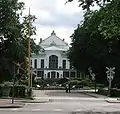 Theatre
Theatre Heliga Trefaldighetskyrkan
Heliga Trefaldighetskyrkan "Kvarnen"
"Kvarnen" Lilla torg
Lilla torg Old railroad bridge across Helge å
Old railroad bridge across Helge å
See also
References
- Some material has been incorporated from the corresponding article on Swedish Wikipedia
Brew, Margit Scandinavian footprints: a history of Scandinavians settling in New Zealand Auckland, NZ: M.Brew, c2007.
Notes
- "Tätorter 2016; befolkning, landareal, andel som överlappas av fritidshusområden" (in Swedish). Statistics Sweden. 5 April 2017. Retrieved 16 April 2017.
- "Kristianstad". Collins English Dictionary. HarperCollins. Retrieved 24 April 2019.
- Jöran Sahlgren; Gösta Bergman (1979). Svenska ortnamn med uttalsuppgifter (in Swedish). p. 14.
- Alfred Jensen: Mazepa, p.174–194. Lund 1909.
- 300th anniversary of first Ukrainian constitution written by Pylyp Orlyk being celebrated, Kyiv Post (April 5, 2010)
- "Kristianstads kommun, kommunarkivet". Archived from the original on 5 January 2006. Retrieved 22 March 2008.
- "Skydd mot översvämningar (Protection from flooding)". Retrieved 2016-08-16.
- "Summary". www.vattenriket.kristianstad.se. Retrieved 2016-08-15.
- "Precipitation Averages 1961-90 (Kristianstad code 6403)". SMHI. March 2016. Archived from the original on 28 September 2018. Retrieved 7 March 2016.
- "Statistics from Weather Stations" (in Swedish). SMHI. June 2017. Archived from the original on 25 December 2018. Retrieved 13 June 2017.
- "Using Waste, Swedish City Cuts Its Fossil Fuel Use". New York Times. December 10, 2010.
- "Twin Cities". Kristianstad. Archived from the original on 6 April 2016. Retrieved 29 April 2014.
